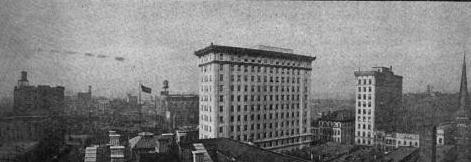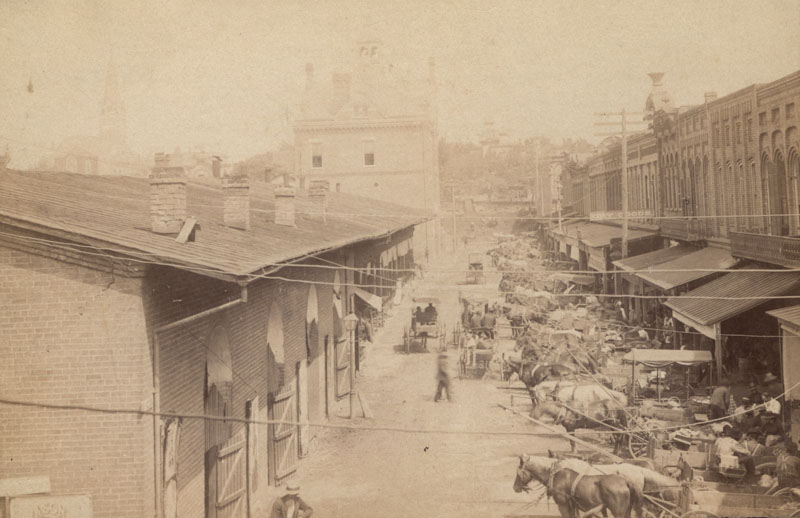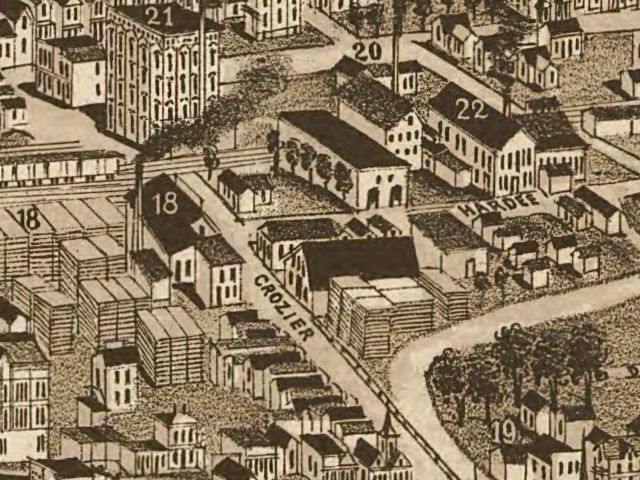|
Gay Street (Knoxville)
Gay Street is a street in Knoxville, Tennessee, United States, that traverses the heart of the city's downtown area. Since its development in the 1790s, Gay Street has served as the city's principal financial and commercial thoroughfare, and has played a primary role in the city's historical and cultural development. The street contains Knoxville's largest office buildings and oldest commercial structures. Several buildings on Gay Street have been listed on the National Register of Historic Places. Part of Charles McClung's original 1791 plat of Knoxville, Gay Street was a focal point for the early political activity of both the city as well as the State of Tennessee. By 1850, Gay Street was home to three-fourths of Knoxville's commercial activity, and in 1854, the street became Knoxville's first paved road.East Tennessee Historical Society, Lucile Deaderick (ed.), ''Heart of the Valley: A History of Knoxville, Tennessee'' (Knoxville, Tenn.: East Tennessee Historical Society, 197 ... [...More Info...] [...Related Items...] OR: [Wikipedia] [Google] [Baidu] |
Knoxville, Tennessee
Knoxville is a city in and the county seat of Knox County, Tennessee, Knox County in the U.S. state of Tennessee. As of the 2020 United States census, Knoxville's population was 190,740, making it the largest city in the East Tennessee Grand Divisions of Tennessee, Grand Division and the state's third largest city after Nashville, Tennessee, Nashville and Memphis, Tennessee, Memphis.U.S. Census Bureau2010 Census Interactive Population Search. Retrieved: December 20, 2011. Knoxville is the principal city of the Knoxville Metropolitan Area, Knoxville Metropolitan Statistical Area, which had an estimated population of 869,046 in 2019. First settled in 1786, Knoxville was the first capital of Tennessee. The city struggled with geographic isolation throughout the early 19th century. The History of rail transportation in the United States#Early period (1826–1860), arrival of the railroad in 1855 led to an economic boom. The city was bitterly Tennessee in the American Civil War#Tenne ... [...More Info...] [...Related Items...] OR: [Wikipedia] [Google] [Baidu] |
WATE-TV
WATE-TV (channel 6) is a television station in Knoxville, Tennessee, United States, affiliated with American Broadcasting Company, ABC and owned by Nexstar Media Group. The station's studios are located in the Greystone (Knoxville, Tennessee), Greystone mansion on North Broadway/Tennessee State Route 33, SR 33/Tennessee State Route 71, SR 71/U.S. Route 441, US 441, and its transmitter is located on Sharp's Ridge in North Knoxville. History Channel 6 was East Tennessee's first television station, signing on the air at 8 p.m. on October 1, 1953, as WROL-TV. The race to be the first television station in the eastern part of the state was won by WROL-TV when the tower of WJHL-TV in Johnson City, Tennessee, Johnson City (ironically, now a sister station to the Knoxville station) collapsed a few months earlier. That station would have been first to sign on, but WROL claimed the title by 26 days. Its first studios were underneath the self-supporting tower on Sharp's Ridge which was on ... [...More Info...] [...Related Items...] OR: [Wikipedia] [Google] [Baidu] |
Mechanics' Bank And Trust Company Building
The Mechanics' Bank and Trust Company Building is an office building located at 612 Gay Street (Knoxville), South Gay Street in Knoxville, Tennessee, United States. Built in 1907 for the Mechanics' Bank and Trust Company, the building now houses offices for several law firms and financial agencies. The building's facade was constructed with locally quarried marble, and is designed in the Second Renaissance Revival style. In 1983, the building was added to the National Register of Historic Places for its architectural significance. The Mechanics' National Bank was chartered in 1882, and moved into a building at what is now 612 South Gay that same year. Within a few months of opening, the bank's president, Thomas O'Connor, was killed in a notorious shootout. In 1907, after the bank reorganized as the Mechanics' Bank and Trust, it built the first three floors of the current Mechanics' Bank building. The Union National Bank absorbed Mechanics' Bank in 1922, and added the top two ... [...More Info...] [...Related Items...] OR: [Wikipedia] [Google] [Baidu] |
The Holston
The Holston is a condominium high-rise located at 531 Gay Street (Knoxville), South Gay Street in Knoxville, Tennessee, Knoxville, Tennessee, United States. Completed in 1913 as the headquarters for the Holston National Bank, the fourteen-story building was the tallest in Knoxville until the construction in the late 1920s of the Andrew Johnson Building, Andrew Johnson Hotel, located a few blocks away. The Holston was designed by architect John Kevan Peebles, and today represents the city's only Neoclassical architecture, Neoclassical Revival-style high-rise. In 1979, the building was added to the National Register of Historic Places for its architecture and its prominent position in the Knoxville skyline. Founded in 1890, Holston National Bank had grown to become one of Knoxville's three largest banks by 1913, when it built the first twelve stories of the Holston building.East Tennessee Historical Society, Lucile Deaderick (ed.), ''Heart of the Valley: A History of Knoxville, Ten ... [...More Info...] [...Related Items...] OR: [Wikipedia] [Google] [Baidu] |
Fidelity Building (Knoxville)
The Fidelity Building is an office building in Knoxville, Tennessee, United States. Initially constructed in 1871 for the wholesale firm Cowan, McClung and Company, the building underwent an exterior renovation and was converted to Fidelity-Bankers Trust Company in 1929 and has since been renovated for use as office space. In 1984, the building was added to the National Register of Historic Places for its architecture and its role in Knoxville's late-nineteenth century wholesaling industry. Cowan, McClung and Company was formed in 1858 by Knoxville merchants James H. Cowan, Perez Dickinson, and several members of the McClung family. During the years following the Civil War, the company became one of the most profitable in Tennessee as Knoxville's wholesaling market grew exponentially. The company erected its four-story headquarters on Gay Street's 500-block in 1871, and occupied the building until 1919. Another wholesale firm, Anderson-Dulin-Varnell, operated out of the buildi ... [...More Info...] [...Related Items...] OR: [Wikipedia] [Google] [Baidu] |
Market Square, Knoxville
Market Square is a historic district and pedestrian mall located in downtown Knoxville, Tennessee, United States. Established in 1854 as a market place for regional farmers, the square has developed over the decades into a multipurpose venue that accommodates events ranging from concerts to political rallies, and has long provided a popular gathering place for artists, street musicians, war veterans, and activists. Along with the Market House, Market Square was home to Knoxville's City Hall from 1868 to 1924. Market Square was listed on the National Register of Historic Places in 1984. Land for the market place was given to the city by William G. Swan and Joseph A. Mabry.The Fragile 15 List of Knox County's Most Endangered Properties , Knox Heritage, Inc., 2006 (accessed March 2, 2009) [...More Info...] [...Related Items...] OR: [Wikipedia] [Google] [Baidu] |
Southern Terminal, Knoxville, Tennessee
The Southern Terminal is a former railway complex located at 306 West Depot Avenue in Knoxville, Tennessee, USA. The complex, which includes a passenger terminal and express depot adjacent to a large railyard, was built in 1903 by the Southern Railway. Both the terminal and depot were designed by noted train station architect Frank Pierce Milburn (1868–1926). In 1985, the terminal complex, along with several dozen warehouses and storefronts in the adjacent Old City and vicinity, were listed on the National Register of Historic Places as the Southern Terminal and Warehouse Historic District. During the 1850s, the arrival of the railroad— namely the East Tennessee, Virginia and Georgia Railroad and its predecessor lines— transformed Knoxville from a small river town of just over 2,000 residents to one of the southeast's major wholesaling centers. Wholesaling firms built dozens of large warehouses along Jackson Avenue and adjacent streets, where smalltown mercha ... [...More Info...] [...Related Items...] OR: [Wikipedia] [Google] [Baidu] |
Old City (Knoxville)
The Old City is a neighborhood in Knoxville, Tennessee, United States, located at the northeast corner of the city's downtown area. Originally part of a raucous and vice-ridden section of town known as "The Bowery," the Old City has since been revitalized through extensive redevelopment efforts carried out during the 1980s through the present.Melonee McKinney, "A Time of Transition an Avenue of Renaissance in Knoxville." ''Knoxville News Sentinel'', 3 April 1994. Currently, the Old City is an offbeat urban neighborhood, home to several unique restaurants, bars, clubs, and shops. In spite of its name, the Old City is not the oldest section of Knoxville. Most of the neighborhood was not part of the city until the 1850s, when the arrival of the railroad encouraged the city to annex the areas north of Vine Avenue.Jack Neely, ''Market Square: A History of the Most Democratic Place on Earth'' (Knoxville, Tenn.: Market Square District Association, 2009), pp. 7, 18, 100. The railroad bro ... [...More Info...] [...Related Items...] OR: [Wikipedia] [Google] [Baidu] |
State Route 1 (Tennessee)
State Route 1 (SR 1), known as the Memphis to Bristol Highway, is a mostly-unsigned state highway in the U.S. state of Tennessee. It stretches all the way from the Arkansas state line at Memphis in the southwest corner of the state to Bristol in the northeast part. Most of the route travels concurrently with U.S. Route 70 (US 70) and US 11W. It is the longest highway of any kind in the state of Tennessee. The route is signed as both in the state of Tennessee, a Primary and Secondary Highway (at different times throughout its designation) In 2015, the Tennessee Department of Transportation erected signs along SR 1 showing motorists they are traveling on the Memphis to Bristol Highway, Tennessee's first state road. TDOT installed the signs at every county line while it celebrated its 100th anniversary. Route description Memphis Area SR 1 begins as a primary route on Interstate 55 (I-55) in the middle of the Memphis & Arkansas Bridge at the Arkansas–Tennessee state line. US 61 ... [...More Info...] [...Related Items...] OR: [Wikipedia] [Google] [Baidu] |
Interstate 40
Interstate 40 (I-40) is a major east–west Interstate Highway running through the south-central portion of the United States. At a length of , it is the third-longest Interstate Highway in the country, after I-90 and I-80. From west to east, it passes through California, Arizona, New Mexico, Texas, Oklahoma, Arkansas, Tennessee, and North Carolina. Its western end is at I-15 in Barstow, California, while its eastern end is at a concurrency of U.S. Route 117 (US 117) and North Carolina Highway 132 (NC 132) in Wilmington, North Carolina. Major cities served by the interstate include Flagstaff, Arizona; Albuquerque, New Mexico; Amarillo, Texas; Oklahoma City, Oklahoma; Little Rock, Arkansas; Memphis, Nashville, and Knoxville in Tennessee; and Asheville, Winston-Salem, Greensboro, Durham, Raleigh, and Wilmington in North Carolina. Much of the western part of I-40, from Barstow to Oklahoma City, parallels or overlays the historic U.S. Route 66. East of Oklaho ... [...More Info...] [...Related Items...] OR: [Wikipedia] [Google] [Baidu] |
Old Gray Cemetery
Old Gray Cemetery is the second-oldest cemetery in Knoxville, Tennessee, United States. Established in 1850, the cemetery contains the graves of some of Knoxville's most influential citizens, ranging from politicians and soldiers, to artists and activists. The cemetery is also noted for the Victorian era marble sculpture and elaborate carvings adorning many of the grave markers and headstones. In 1996, the cemetery was added to the National Register of Historic Places. Named for English poet Thomas Gray (1716–1771), Old Gray Cemetery is an example of a so-called garden cemetery, a mid-19th-century style that sought the transition of graveyards from urban churchyards to quiet suburban plots. Unlike its crowded predecessor, the First Presbyterian Church Cemetery, Old Gray features spacious graves, grand monuments, and extensive vegetation, and its layout bears more resemblance to a public park. Playwright Tennessee Williams mentions Old Gray in his short story, "The Man in t ... [...More Info...] [...Related Items...] OR: [Wikipedia] [Google] [Baidu] |







